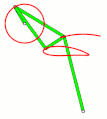Source
This Walking mechanism was first published by Joseph E. Shigley.[1]
This chapter follows the original paper very closely. This is not mend as a plagiarism, but for making this chapter easier to understand.
Description
This mechanism has a nice looking locus:
Unfortunately, one of the fix points and rockers is below ground.As suggested by Shigley, the lower fix point and rocker can be replaced by a groove:
Using such a groove opens up a large number of possibilities, as the groove does not need to be a circular segment.
Even when using rockers and bars, grooves can be used as an addtional support, making a mechanism robuster.[2]
Dimensions
In the original paper, not all dimensions are given.
As the drawing in the paper are to scale, the missing dimensions can be measured from the drawing:
Note that any error in the dimension is my (the author of the book) fault. Before making statements about the mechanism, consult the original paper by Shigley and if in doubt try to optimize the linkage for your use case.
- ↑ Shigley, Joseph E. “The Mechanics of Walking Vehicles: A Feasibility Study.” University of Michigan Department of Mechanical Engineering. 1960.
- ↑ as seen in this video: https://www.youtube.com/watch?v=mGOled86Sjo

